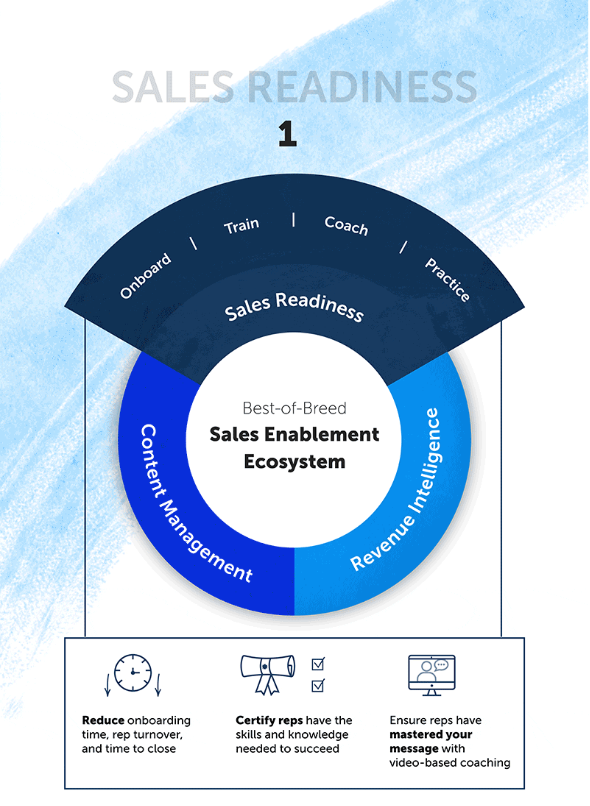What is sales readiness? And why should you care?

The first version of this post originally appeared on Forbes in February 2018.
What does it mean to “be ready”? What is the best way to get ready? And how do you know when it’s time to stop preparing and start selling?
Sales readiness helps answer those questions for sales reps, managers, and enablement teams.
Let’s take a look at how it works and why it should matter to you — starting with a definition.
What is sales readiness?
Sales readiness (SR) involves onboarding and training salespeople and certifying whether they possess the skills and knowledge needed to have effective conversations throughout the buyer’s journey.

Key sales readiness activities include assessment, certification, training, onboarding, and coaching. Sales readiness systems are designed to reduce onboarding time and rep turnover and help develop more productive, agile, and buyer-ready sellers — hence the name.
Sales readiness in 2024
Per our definition, the primary goal of sales readiness programs is to prepare reps to close more and bigger deals.
However, in 2024 and beyond, it will be more important that buyers leave their interaction — whether it happened face-to-face, on the phone, in a web conference, or via email — feeling their time was well-spent.
Even if a deal can’t move forward, you want the buyer to think, “That’s a company I’d like to do business with,” or, “That’s someone I’d want on my sales team.”
Because what buyers think and feel matters in both the short and long term.
Salesforce’s 2022 customer research surfaced insightful feedback in this regard, with “88% of customers saying the experience a company provides is as important as its product or services — up from 80% in 2020.”
With buyer experience becoming one of, if not THE, key differentiator for businesses, sales organizations should take full advantage of sales readiness tools and programs that help reps improve their interpersonal skills and even the vibes they put out — BEFORE they interact with a customer.
A common gaffe is to force reps to learn in the field and “practice” on the people they’re selling to, which is unfair to both the buyer and seller.
Why does sales readiness matter?
We talk a lot about reps being buyer-ready. As in ready to face the buyer, the human being who will have an individual communication style, concerns, needs, and questions.

The importance of buyer-focused sales readiness is perfectly illustrated by this story from former Chief Readiness Officer of Brainshark, Jim Ninivaggi:
“I was brought in to consult at a Fortune 500 software company that hadn’t adequately prepared its sales team for change. Business was, ostensibly, good, and investments in the company’s cloud-computing services were rising.
At the same time, though, the industry was seeing a major shift in who purchased software. Recognizing that chief marketing officers (CMOs) were grabbing budgets from chief information officers (CIOs) and IT, the company executed a huge campaign focused on the CMO buyer. It was a resounding success — from a marketing perspective, that is — and flooded the sales team with leads.
But then deals stalled. The sales reps, who’d only had conversations with CIOs in the past, floundered when trying to capitalize on the demand. Faced with a new breed of buyer, reps didn’t know what questions to ask and what the value proposition was. Reps were neither confident nor competent. In short, they weren’t ready.
These types of struggles aren’t unique. It turns out, a lot of salespeople simply aren’t ready to engage with new buyers. In fact, executive buyers say eight of 10 sales meetings they take are a waste of time, according to Forrester. These lost opportunities and the resulting lost revenue underscore why sales readiness is so important.
Having recognized its lapses, the aforementioned software company worked to get reps ready to pivot — providing manager-led training, eLearning and sales readiness assessments on how to sell to the CMO role. Then, at its annual sales kickoff, the company brought in former CMOs the reps could practice on. They provided feedback and objections in an important setting — one where real-world stakes weren’t at play.”
Tips to improve sales readiness
1. Develop core competencies through proactive learning
The traditional “if-you-build-it, they-will-come” approach to continuous learning programs doesn’t work in sales. Instead, organizations need to move from a reactive learning model — where the onus is on reps to participate — to a proactive approach.
This means pushing out microlearning content — ideally in bite-sized video/multimedia modules — at regular intervals and establishing that competencies will be measured and mastered.
See also: How Microlearning Improves Customer Experience and Closes More Deals
2. Tie readiness into your growth strategy
Consider the five paths Forrester recommends for B2B growth:
- Expanding into new markets
- Targeting new buyers
- Launching new products
- Growing through mergers and acquisitions
- Driving productivity
It’s important for companies to articulate and align around what their key growth lever(s) will be at a given time. Then, sales enablement leaders need to build their readiness programs to support that with the end in mind. This means asking, “What kind of conversations do our salespeople need to have to be successful with our strategy?”
If the answer is radically different than the status quo (as with the software company, on growth path #2), this usually merits a heavier investment in sales readiness.
Just as you can’t change a football team’s offensive scheme from passing-focused to running-focused or a dance company’s emphasis from classical ballet to modern without supporting those skill sets, you also can’t execute a sales transformation without the right talent in place.
3. Start with sales manager enablement
For many companies — and the company in our example — it’s important to start the sales transformation with an emphasis on its front-line managers so readiness becomes a top-down approach. Expecting managers to coach to a foreign skill set is unrealistic — they need to also have that skill set, first.
The company from Jim’s story worked to train and certify its managers, putting them through the same rigorous process the reps would go through and making the managers active participants in the training and its rollout. This foundation enabled managers to provide and support rep training, video assessments and field coaching initiatives.
Ready? Then ready, set, go!
As reps become more equipped to conduct impactful conversations with customers, their confidence breeds competence — and success. By emphasizing sales readiness, that software company was able to capture a significant portion of the marketing analytics market and continues to be viewed as a trusted partner for CMOs today.
Learn how your company can enable your sellers to move beyond being “prospect ready” and instead be “buyer ready”: Helping Sellers Become Buyer Ready

